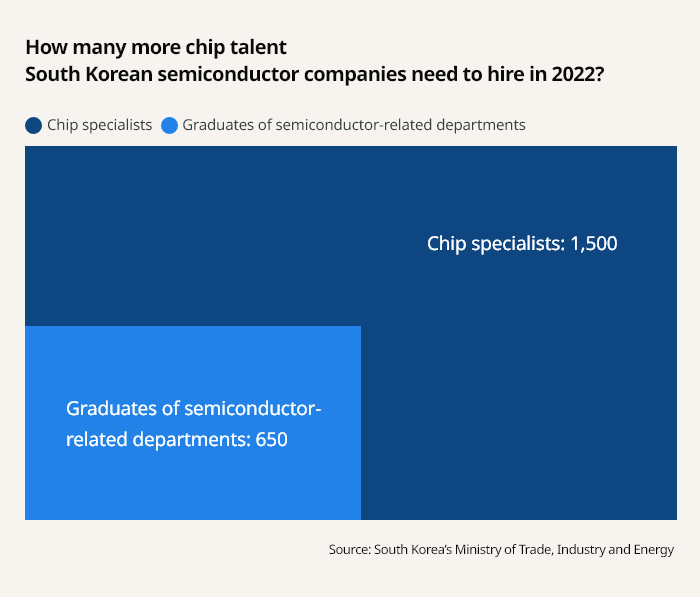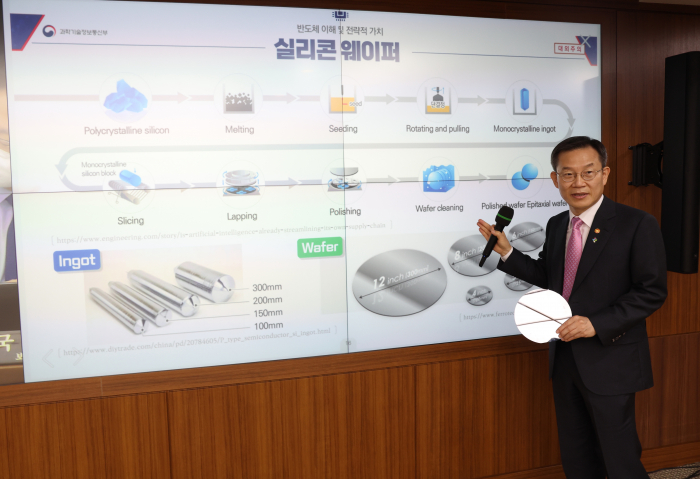Why Korean chipmakers struggle with talent shortages
The government has been grappling with opposition from lawmakers and conservative academia
By Jun 10, 2022 (Gmt+09:00)
LG Chem to sell water filter business to Glenwood PE for $692 million


Kyobo Life poised to buy Japan’s SBI Group-owned savings bank


KT&G eyes overseas M&A after rejecting activist fund's offer


StockX in merger talks with Naver’s online reseller Kream


Mirae Asset to be named Korea Post’s core real estate fund operator



South Korean President Yoon Suk-yeol on Tuesday lashed out at Vice Education Minister Chang Sang-wan during a cabinet meeting, after Chang pointed to regulations to justify its slow response to the growing calls for opening more semiconductor-related departments at local universities.
“If the education ministry fails to play a leading role in nurturing talent needed for the South Korean economy, it will be the education ministry itself that needs to be reformed,” Yoon was quoted as saying in the meeting.
Urged to “change its way of thinking” by Yoon, the education ministry is scurrying to find solutions, which may include drastic regulatory changes, to resolve the shortage of high-quality semiconductor workers. The move comes as the US, Europe, China and Taiwan are all ramping up spending to grow their chip industry.
Over the next 10 years, South Korea’s semiconductor industry is expected to face a shortage of at least 30,000 workers, according to the Korea Semiconductor Industry Association.
During the period, about 1,500 to 1,600 new positions will be created in the chip industry per year, according to the association. But South Korea produces less than half the required number, or about 650 fresh graduates with a degree in the field of semiconductors or related studies at local universities per year.
“We are studying various measures to expand the student quota (related to the semiconductor industry), in addition to opening employment-linked departments at universities,” an education ministry official told The Korea Economic Daily on June 9.
But that is not as simple as it may seem. The "change its way of thinking" will face strong resistance from politicians and lawmakers representing non-Seoul metropolitan areas.
STUDENT QUOTA AT UNIVERSITIES IN SEOUL METROPOLITAN AREA
First, the student quota at colleges in Seoul and neighboring Gyeonggi Province remains the key obstacle to expanding the number of semiconductor-related students at local universities.
South Korea introduced the quota in 1994 with an aim to decrease population density in the capital region, in which about half of the country’s 50 million population reside.
Universities may get around the law by reducing the number of entrants to other departments, particularly, non-mainstream majors in college to make room for semiconductor-related departments.
But that suggestion has been hamstrung by strong opposition from professors and alumni of the relevant departments.
Alternatively, separate standards could be drawn up to give a special dispensation to universities, or semiconductor-related departments, seeking to expand the number of their entrants. In other words, they might be exempt from the current law aimed at easing population concentration.
During a visit to SK Hynix’s main production facilities in Icheon, Gyeonggi Province on Thursday, Prime Minister Han Duk-soo vowed that the government will significantly increase the student quota at universities in both the Seoul capital area and other regions. To do so, the government is willing to provide financial assistance to the academic institutions, he noted.
However, these options are subject to approval from the National Assembly, in which liberal democrats, supportive of balanced regional development, will continue to hold a majority over the next two years.

CONSERVATIVE ACADEMIA
Secondly, the country’s top academy, Seoul National University, has been holding out on the proposal to establish a semiconductor department, graduates of which will be guaranteed jobs at its sponsor company such as Samsung Electronics Co. or SK Hynix Inc., on top of scholarships and exemption of entrance fee and tuition.
A majority of the university’s professors oppose the offer on the ground that universities are not a place for training technical workers.
OPPOSITION FROM LAWMAKERS
Thirdly, the trickiest issue is how to win support from lawmakers representing rural districts.
An increased quota at universities in Seoul and surrounding areas would lead to a further decrease in the number of students in other regions.
That would worsen the financial difficulties at universities in non-Seoul areas, already suffering from a shrinking number of applicants on the back of the declining birth rate.
For that reason, lawmakers elected for rural districts are trying hard to block the passage of any law related to an increase in the number of students or opening semiconductor-related departments at universities in the Seoul metropolitan area.
Former President Moon Jae-in also failed to win parliamentary support for similar policy efforts.
“To meet halfway, universities in the Seoul region should cut the total number of students, while securing a slot for the semiconductor-related department,” said a president of a Seoul-based private university.
“For their part, universities in other regions may need to take a step back for the national interest.”
| South Korean universities with semiconductor-related departments | |
| University | Sponsor Company |
| *KAIST | Samsung Electronics |
| *POSTECH | Samsung Electronics |
| Yonsei University | Samsung Electronics, LG Display |
| Korea University | Samsung Electronics, SK Hynix, Hyundai Motor |
| *Sogang University | SK Hynix |
| Sungkyunkwan University | Samsung Electronics |
| *Hanyang University | SK Hynix |
| (Note: *Four universities will accept students for the chip-related departments from 2023) | |
COMPETITION WITH GAMING FIRMS, ONLINE PLATFORM
Another challenge in finding skilled workers is the rise of platform and gaming companies such as Naver Corp., Kakao Corp and NCsoft Corp., which have jacked up pay to attract and retain talent.
Their locations in urban and suburban areas are another factor that attracts qualified workers, whereas chipmakers’ plants are usually located away from urban areas.
Further, the growing preference for medical schools among high school students makes it difficult to produce as many skilled workers as before.

WHY NOW?
Semiconductor companies have so far educated their new hires through on-the-job training. But the rapid technological advances and sophisticated production processes are increasing the demand for more skilled and highly-educated workers.
To cope with the manpower shortage, South Korea plans to loosen its standards of picking ailing universities subject to a cut in the number of entrants, as long as they meet certain requirements for opening high-tech departments.
Such policy proposals come after Samsung and SK Hynix unveiled massive investment plans for the next five years to maintain their leadership in the chipmarket.
Taiwan, home to the foundry leader TSMC, plans to allow universities to recruit new students majoring in semiconductors twice a year to nurture about 10,000 chip experts annually.
Write to Man-Su Choe, Ji-Eun Jeong and Ye-Rin Choi at bebop@hankyung.com
Yeonhee Kim edited this article.
-
 Korean chipmakersKorea may be backpedaling in semiconductor push: Lawmaker
Korean chipmakersKorea may be backpedaling in semiconductor push: LawmakerMay 20, 2022 (Gmt+09:00)
4 Min read -
 Korean chipmakersKorea losing ground in semiconductor talent development
Korean chipmakersKorea losing ground in semiconductor talent developmentMay 09, 2022 (Gmt+09:00)
3 Min read -
 Korean chipmakersSamsung, SK Hynix scramble for talent amid a lack government support
Korean chipmakersSamsung, SK Hynix scramble for talent amid a lack government supportMay 06, 2022 (Gmt+09:00)
6 Min read


